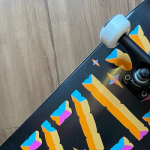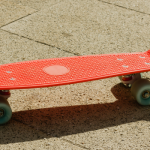Skateboard trucks are the metal T-shaped pieces that mount onto the underside of the skateboard deck and keep your skateboard wheels and bearings securely attached. But have you ever wondered which way they should go on a skateboard? If you’re new to skateboarding or even if you’re an experienced skater setting up a new board, it’s crucial to understand the correct orientation of the trucks.
Incorrect placement can affect your balance, turning capabilities, and overall riding experience. The direction of the trucks might seem like a small detail, but it plays a significant role in the performance of your skateboard. In this article, we’ll explore the correct way to position your skateboard trucks, why it matters, and how it influences your ride. Whether you’re a novice or seasoned skater, this guide will ensure your skateboard setup is optimized for the best possible performance.
Direction of Skateboard Movement:
The direction in which a skateboard moves is entirely dependent on the rider’s preference and skill. There’s no fixed rule for which end of the skateboard should go in front. However, some skaters have a preferred stance:
Regular Stance:
- In a regular stance, the left foot is placed at the front of the skateboard.
- The rider pushes and propels the skateboard forward using their right foot.
Goofy Stance:
- In a goofy stance, the right foot is positioned at the front.
- The rider pushes and controls the skateboard with their left foot.
The determination of which stance a skater adopts is highly subjective and varies from person to person.
It often comes down to what feels most natural and comfortable for the individual. Factors such as the dominant foot, balance, and pushing preferences play a significant role in shaping a skater’s preferred stance.
Which Way Do Trucks Go on a Skateboard?
When it comes to the direction of trucks on a skateboard, there is no right or wrong answer. The placement of the trucks depends entirely on which way you ride your board.
Hanger Direction:
- The hanger is the T-shaped part of the truck.
- It should be positioned facing outward, towards the edges of the skateboard deck.
Kingpin Position:
- The kingpin is the large bolt that holds the truck together.
- It should be facing towards the center of the skateboard.
Axle Placement:
- The axles, the metal rods that run through the wheels, should be parallel to the deck.
- Ensure that the wheels are symmetrically positioned on both sides of the skateboard.
Bushings:
- Bushings are the soft, rubbery components that provide cushioning and allow the trucks to turn.
- Install the bushings according to the manufacturer’s recommendations, usually with a cone-shaped bushing on the board side and a barrel-shaped bushing on the roadside.
Mounting Hardware:
- Use the correct mounting hardware to secure the trucks to the skateboard deck.
- Tighten the bolts evenly to ensure stability and proper performance.
Why Does It Matter?
The direction of skateboard trucks may seem insignificant, but it can affect your riding experience in various ways. Let’s take a closer look at why it matters.
Balance:
Ensuring that your trucks are mounted correctly can improve and optimize your balance on the board. Incorrect placement can throw off your center of gravity, making it more challenging to maintain stability while riding.
Turning Capabilities:
The direction of the trucks also plays a crucial role in how you turn and maneuver on a skateboard. Proper truck orientation allows for smoother turns, making it easier to navigate through different terrains and obstacles.
Performance:
Ultimately, the direction of skateboard trucks can significantly impact your overall riding performance. Correctly placed trucks allow for better stability, control, and maneuverability, ultimately enhancing your skateboarding experience.
Conclusion:
When setting up a skateboard, ensuring the proper orientation of trucks is crucial for optimal performance.
The hanger should face outward, the kingpin towards the center, and the axles parallel to the deck.
Adhering to these guidelines, along with appropriate bushing installation, provides stability and responsiveness.
Skateboarders are encouraged to experiment with setups to find the configuration that best suits their preferences, allowing for a personalized and enjoyable riding experience.
![Why do skateboarders hate scooters? [Reasons + Tips] Why do skateboarders hate scooters? [Reasons + Tips]](https://bedoper.site/wp-content/uploads/2023/04/Why-do-skateboarders-hate-scooters-150x150.png)


![How fast do skateboards go downhill? [90 mph (145 km/h)] How fast do skateboards go downhill? [90 mph (145 km/h)]](https://bedoper.site/wp-content/uploads/2023/04/How-fast-do-skateboards-go-downhill-150x150.png)
